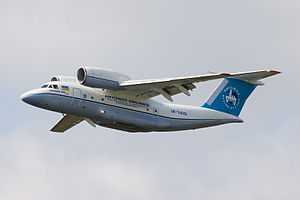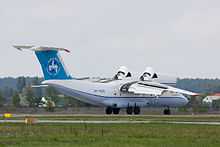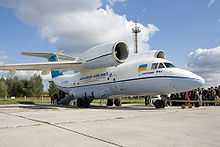Antonov An-74
| An-74 | |
|---|---|
 | |
| Antonov Airlines An-74T at Gostomel Airport, Ukraine. | |
| Role | Military transport |
| National origin | Soviet Union Ukraine |
| Manufacturer | Antonov |
| First flight | November 1983 |
| Introduction | 1983 |
| Status | Operational |
| Primary users | Russian Air Force Egyptian Air Force Islamic Republic of Iran Air Force |
| Produced | 1986–present |
| Number built | 195 (An-72 & An-74)[1] |
| Developed from | Antonov An-72 |
The Antonov An-74 (NATO reporting name Coaler) is a Soviet/Ukrainian transport aircraft, developed by Antonov. It is a variant of the An-72.
The An-72 and An-74 get their nickname, Cheburashka, from the large engine intake ducts, which resemble the oversized ears of the popular Soviet animated character of the same name.
Design and development
The An-74 was initially an upgrade of the An-72 test aircraft, intended to be used in the Arctic and Antarctica; and had the designation An-72A "Arctic".[2] The aircraft's main purpose is to deliver cargo, equipment and personnel over short- and medium-range routes in any climatic conditions ranging from −60°C to +45°C and at any latitudes, including the North Pole, and high altitudes. It can operate to and from low grade airstrips such as concrete, pebble, ice and snow aerodromes.
Produced in tandem with the An-72, the An-74 can be fitted with wheel-ski landing gear, de-icing equipment and a number of other upgrades allowing the aircraft to support operations in Arctic or Antarctic environments.
An unusual design feature of the An-74 (as well as An-72) is the use of the Coandă effect to improve STOL performance, utilizing engine exhaust gases blown over the wing's upper surface to boost lift. The power plant used is the Lotarev D-36 turbofan engine. The An-74 bears a resemblance to the Boeing YC-14, a prototype design from the early 1970s which had also used overwing engines and the Coandă effect.
The rear fuselage of the aircraft has a hinged loading ramp with a rear fairing that slides backwards and up to clear the opening. The An-74 has a payload of 7.5 tons including up to 10 passengers in the cargo version, or up to 52 seats in the passenger version; operating ceiling of 10,100 metres (33,100 ft) and cruising speed of 550 to 700 kilometres per hour (300 to 380 kn). The aircraft may also be used for highly specialized operations:
- pilotage and vessel escort;
- establishing and servicing of drifting stations;
- research operations in Arctic or Antarctic regions;
- visual ice patrol;
- fishery reconnaissance.
Operational history
As of January 1, 2006, 23 out of 30 aircraft registered in Russia were in operation.
Variants

- An-74: Arctic/Antarctic support model with room for five crew, increased fuel capacity, larger radar in bulged nose radome, improved navigation equipment, better de-icing equipment, and can be fitted with wheel-skis landing gear.
- An-74A: Passenger or freighter model.
- An-74MP: Marine Patrol version. Can transport 44 soldiers, 22 para-troops, 16 stretchers with medical staff, or 10 tonnes of cargo.
- An-74T: Freighter version equipped with an internal winch, roller equipment, and cargo mooring points, can also be fitted with static lines for paratroops or dropping air cargo.
- An-74T-100: Variant of the An-74T fitted with a navigator station.
- An-74D
- An-74-100: Variant of the An-74T fitted with a navigator station
- An-74-200: Military transport based on the An-74T
- An-74TK: Convertible passenger/cargo model that can be equipped for up to 52 passengers, all cargo, or a mix of the two.
- An-74TK-100: Variant of the An-74TK fitted with a navigator station.
- An-74TK-200: Variant of the An-74TK configured for only two flight crew
- An-74TK-200C: Cargo variant of An-74TK-200
- An-74T-200: Military Transport aircraft
- An-74T-200A: Military Transport aircraft[3] [4]
- An-74TK-300: An-74TK model primarily for civil customers with more fuel efficient engines on conventional underwing pylons that gives up the STOL capabilities of earlier models in favor of lower operating cost and higher speed, also incorporates improved avionics and passenger comfort features
- An-74TK-300D: An An-74 with engines fitted underneath the wings [5] [6]
- An-74-400: Proposed stretch model of the An-74TK-300 with a fuselage insert to extend length by 26 ft (8 m), also would be equipped with uprated engines.
Operators
Civilian

- Cavok Air
Military
- Egyptian Air Force: Nine (An-74T-200A) (four more on order)
- Islamic Republic of Iran Air Force: Four (An-74TK-200), seven (An-74T-200); later transferred to Iranian Revolutionary Guard
- Lao People's Liberation Army Air Force: One (An-74TK-300D)[7]
Notable accidents and incidents
- On 16 September 1991, an An-74 carrying a cargo shipment of fish from Petropavlovsk-Kamchatskiy to Kiev via Lensk and Omsk crashed after take-off from Lensk Airport, killing all 13 people on board. The cause of the accident was an overloading of the aircraft, combined with the premature retraction of the wing flaps.[8]
- On 23 April 2006, a Libyan Air Force An-74TK-200 carrying food aid to Chad crashed near the village of Kousséri in neighbouring Cameroon after abandoning its landing at N'Djamena. All six Ukrainian crew members were confirmed dead.[9]
- On 27 November 2006, an Iranian Revolutionary Guards Corps Antonov An-74, serial number 15-2255, crashed on take-off at Tehran Mehrabad Airport. There were 37 fatalities, out of 38 occupants on board the aircraft.[10][11]
- On 17 May 2014, a Lao People's Liberation Army Air Force An-74TK-300 carrying Laos Defence Minister Douangchay Phichit and other senior officials crashed in the north of the country in the Xiangkhouang Province, nearly 500km (311 miles) from the capital Vientiane.[12]
Specifications
Data from The Osprey Encyclopaedia of Russian Aircraft 1875–1995
General characteristics
- Crew: 5 (captain, first officer, navigator, flight engineer, loadmaster)
- Capacity: up to 52 passengers
- Length: 28.07 m (92 ft 1 in)
- Wingspan: 31.89 m (104 ft 7½ in)
- Height: 8.65 m (28 ft 4½ in)
- Wing area: 98.62 m2 (1,062 ft2)
- Empty weight: 19,050 kg (42,000 lb)
- Gross weight: 34,500 kg (76,058 lb)
- Powerplant: 2 × Lotarev D-36 series 1A, 63.9 kN (14,330 lbf) thrust each
Performance
- Maximum speed: 700 km/h (435 mph)
- Cruising speed: 550 / 600 km/h (342 / 373 mph)
- Range: 4,325 km (2,688 miles)
- Service ceiling: 10,100 m (33,136 ft)
See also
- Related development
- Aircraft of comparable role, configuration and era
- Related lists
References
- ↑ "✈ russianplanes.net ✈ наша авиация". russianplanes.net. Retrieved 18 February 2015.
- ↑ "✈ russianplanes.net ✈ наша авиация". russianplanes.net. Retrieved 18 February 2015.
- ↑ "AN-74T-200A - www.naumenko.info". naumenko.info. Retrieved 18 February 2015.
- ↑ "AN-74T-200A". use.kiev.ua. Retrieved 18 February 2015.
- ↑ "AN-74TK-300D - www.naumenko.info". naumenko.info. Retrieved 18 February 2015.
- ↑ "АН-74ТК-300Д". use.kiev.ua. Retrieved 18 February 2015.
- ↑ http://www.aeroflight.co.uk/waf/aa-eastasia/laos/laos-af-aircraft.htm#colt[]
- ↑ Harro Ranter (16 September 1991). "ASN Aircraft accident Antonov 74 CCCP-74002 Lensk Airport". aviation-safety.net. Retrieved 18 February 2015.
- ↑ Harro Ranter (23 April 2006). "ASN Aircraft accident Antonov 74TK-200 UR-74038 Kousséri". aviation-safety.net. Retrieved 18 February 2015.
- ↑ Accident description for 15-2255 at the Aviation Safety Network
- ↑ Wastnage, Justin (27 November 2006). "Picture: Iranian Revolutionary Guards An-74 crashes in Tehran, killing 36. Causes unknown". London: Flightglobal. Archived from the original on 14 July 2013.
- ↑ "BBC News - Laos Deputy PM Douangchay Phichit dies in plane crash". BBC News. Retrieved 18 February 2015.
External links
| Wikimedia Commons has media related to Antonov An-74. |
- An-74TK-200 Technical characteristics
- An-72/An-74 Family ( Data for An-72A & List of all known An-72/An-74 Family variants )
- An-74 Pictures
- An-74TK-200 modification at KSAMC site
- An-74TK-300 modification at KSAMC site
- AN-74TK-300 modification at Antonov's site
- AN-74T modification at Antonov's site
| ||||||||||||||||||||||||||
| ||||||||||||||||||||||